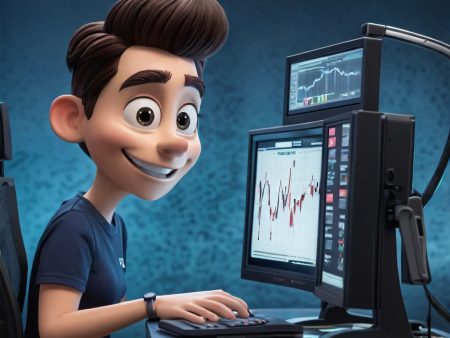Moving averages are a key tool in forex trading, providing traders with a clearer view of market trends, potential signals, and trading opportunities. By smoothing out price data, they make it easier to spot the bigger picture – ideal for everyone from beginner traders to experienced investors.
What Are Moving Averages and How Do They Work?
Moving averages help traders see through short-term fluctuations, giving a better look at trends. They’re a trend-following indicator – which means they’re great at highlighting which way the market is heading, though they do have a slight lag.
Types of Moving Averages
There are several types of moving averages in forex trading, each with its own strengths.
1. Simple Moving Average (SMA)
The SMA calculates the average of a specific number of previous closing prices. For example, a 10-day SMA will add the last 10 days’ closing prices and divide by 10.
2. Exponential Moving Average (EMA)
Unlike the SMA, the EMA gives more weight to recent prices, making it more responsive to the latest market movements.
3. Weighted Moving Average (WMA)
The WMA focuses even more on recent prices than the EMA, using a weighted formula to prioritize new information.
4. Moving Average Ribbon
This is a combination of several moving averages of different periods on one chart, making it easier to spot strong trends or reversals.
How Traders Use Moving Averages
Moving averages can be put to work in various ways, depending on the trader’s goals and timeframe.
1. Identifying Market Trends
If the price is above the moving average, it’s usually a sign of an uptrend. If it’s below, the market is likely in a downtrend. Many traders rely on this simple method to gauge market sentiment.
2. Crossover Strategy
The crossover strategy involves two moving averages – typically, one short-term and one long-term. When the short-term average crosses above the long-term average, it signals a possible buy (often called a “golden cross”). If it crosses below, it’s a potential sell signal (“death cross”).
3. Support and Resistance
Moving averages can act as dynamic support and resistance levels. If the price falls to a moving average line, it might bounce back up, using it as a support level. Similarly, if the price rises to a moving average, it might meet resistance and start declining.
4. Filtering Trades
Many traders use moving averages to filter out trades that don’t align with the trend. For instance, if the price is above a long-term moving average, traders might look only for buy trades to reduce the risk of betting against the trend.
Common Moving Average Strategies in Forex
Moving averages offer a range of strategies, each with unique benefits for different trading styles. Let’s look at a few:
Scalping with Moving Averages
Scalpers, who aim for quick, small gains, often use short-term moving averages (like 5 or 10-period MAs) on minute charts. This strategy helps capture quick price moves in high-volatility markets.
Read more about Scalping Strategy in Forex Trading
Swing Trading
Swing traders, focusing on capturing medium-term price moves, use longer moving averages like the 50-day or 100-day MAs. This approach is ideal for spotting trend reversals or entries at optimal points over several days.
Day Trading with Moving Averages
Day traders use combinations of short and medium-term moving averages across various timeframes (such as 5-minute and 1-hour charts) to make swift decisions based on intraday price action.
Moving Average Envelope Strategy
This involves plotting bands or envelopes around a moving average, helping traders identify potential breakouts. If the price breaches the envelope, it may signal a strong directional movement.
Combining Moving Averages with Other Indicators
Relying on moving averages alone can sometimes lead to false signals. Pairing them with other indicators can boost accuracy.
Relative Strength Index (RSI)
Combining moving averages with RSI can confirm trend signals. For instance, if a crossover suggests a buy but RSI shows the market is overbought, traders might wait for a better entry.
Moving Averages with MACD
MACD uses moving averages in its calculation, and traders often look at both moving average crossovers and MACD signals to spot strong trading opportunities.
Limitations of Moving Averages
While moving averages are valuable tools, they’re not foolproof. Here are a few things to consider:
- Lagging Nature: Moving averages are based on past prices, so they might miss the initial part of a new trend.
- Choppy Markets: In sideways or highly volatile markets, moving averages can give misleading signals, leading to potential losses.
- Signal Delays: Since moving averages are reactive, they can generate signals after significant price moves have already occurred.
Overcoming Limitations
Experienced traders often use multiple timeframes to reduce false signals. For instance, a trader might confirm a signal on both a 15-minute and 1-hour chart to improve the accuracy of their entry.
Real-World Examples and Case Studies
Let’s look at how moving averages have helped traders profit in real trading scenarios:
Case Study 1: Dual Moving Average Crossover in a Trending Market
A trader used a 50-day SMA and a 200-day SMA. When the 50-day SMA crossed above the 200-day SMA, it signaled an uptrend. The trader entered a long position, holding for three months and achieving a 15% profit as the price continued upward.
Case Study 2: Using EMA with Fibonacci Levels
A day trader combined a 21-day EMA with Fibonacci retracement levels. When the price bounced off the 21-day EMA at a 61.8% retracement, it confirmed a buying opportunity. The trader achieved a 10% ROI within a week.
Statistics on Moving Average Effectiveness
Research shows that using moving averages with other indicators can increase trading success rates by about 10-15%. Additionally, traders incorporating stop-loss orders based on moving averages reduced losses by 20-30% in volatile markets.

FAQs on Using Moving Averages in Forex
1. What is the best moving average for forex trading?
It depends on your trading style. Shorter MAs (5-20 periods) are popular for scalping and day trading, while longer MAs (50-200 periods) are better suited for swing trading.
2. How can I avoid false signals with moving averages?
Combine moving averages with other indicators like RSI or MACD. Using multiple timeframes also helps confirm signals before entering a trade.
3. Is the crossover strategy profitable?
Yes, especially in trending markets. In choppy or sideways markets, however, it can produce mixed results. Adjusting the timeframes and adding other filters can improve accuracy.
4. What is the difference between SMA and EMA?
The SMA gives equal weight to all price points in a period, while the EMA prioritizes recent prices, making it more responsive to current price changes.
5. Can moving averages work in a sideways market?
Not effectively. Moving averages work best in trending markets. In a sideways market, they tend to give false signals.
Final Thoughts on Using Moving Averages in Forex Trading
Moving averages can be a powerful tool for identifying trends and potential trading opportunities in the forex market. Whether you’re a scalper, swing trader, or long-term investor, there’s likely a moving average strategy that fits your style. Just remember: they’re best used in conjunction with other indicators and not as a stand-alone signal.
Incorporate moving averages into your trading toolkit, and remember to backtest any strategy you develop. With practice, they can help you navigate the forex market more confidently and, hopefully, more profitably.




